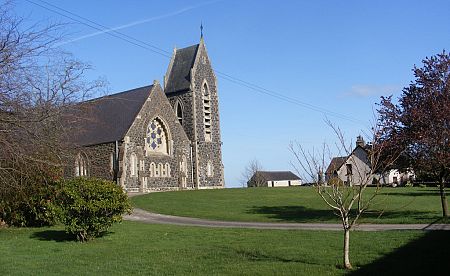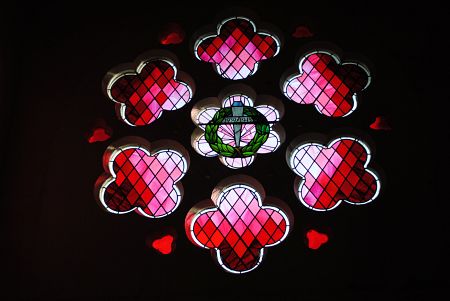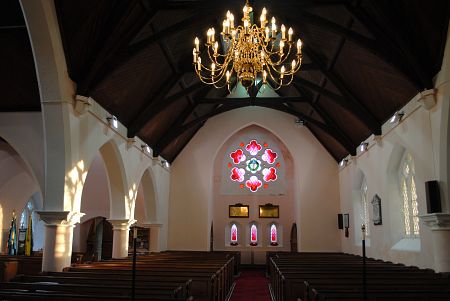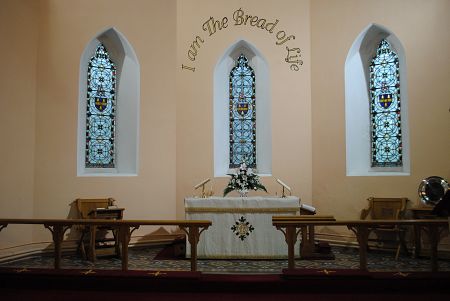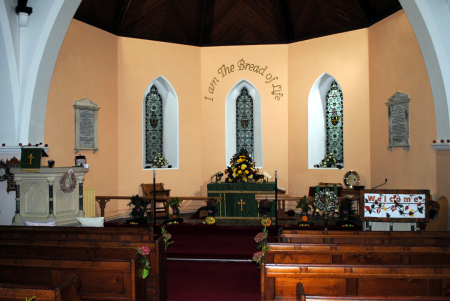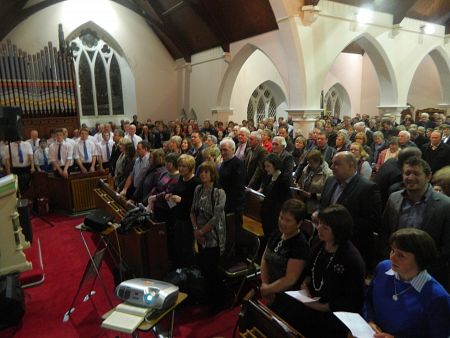History Of Woodschapel - St. John's
Pre-Reformation to 1731
The Parish of Woodschapel existed before the Reformation of the sixteenth century under the name of Ross English, with a Church, Glebe and Glebehouse. This is evident from a return made to King Henry VIII in 1540 A.D. In the parish there is a graveyard known as Eglish, which has a tombstone dated 1700 A.D., it is thought that this was the site of the pre-reformation church. This parish ceased to exist as a separate unit sometime during the late sixteenth century and for the next 200 years it became part of the Parish of Ardtrea. There is no known record of its history from that date until 1730, and no record of when the Church at Eglish ceased to exist. During this time it was known as Lisnamorrow Chapel and when it became a separate parish again it was known as the Chapel of Woods, hence the name Woodschapel. The parish consisted of Aughrim, Ballyronan, Ballymilligan, Ballymulderg, Ballynagarve, Ballyneal, Ballyriff, Caraloon, Drumenagh, Lisnamorrow and Moyola
1731-1862
The first church built at Lisnamorrow was in 1731, (the datestone of this church is preserved in the present church porch, having been placed there in 1923). The Rector of Ardtrea in 1731 was the Rev. John Shadwell, whose name is engraved on the stone. Only a very small portion of the old church still remains in the graveyard to-day. In 1794 William Graves and David Gaussen were appointed trustees to supervise the putting on of a new church roof. The old roof was sold for £11.12s11d., the cost of the new roof is not known. In 1795 it was proposed to erect a gallery to meet the growing needs of the Parish. Once again in 1825 the church was enlarged and entries in the Vestry minutes on 22 June states “it was resolved, with no dissenting voice that it appears to this Vestry that this church is too small for the congregation belonging to it, and that it is necessary to provide additional accommodation in it, as speedily as possible”; a committee was formed and authorised to procure a plan and estimate for an additional aisle, gallery, and a Vestry room. In 1823 the Parishioners elected James Duncan, of Caraloon and George Brown, Ballynagarve as Churchwardens.
The area of the present parish is considerably smaller, as the townlands lying to the East of the Moyola were given to Castledawson in 1874 to form a new Parish there. The townlands of Ballyriff and Ballymilligan now form part of the Parish of Ballyeglish. The present Parish consists of Aughrim, Ballymaguigan, Ballymulderg, Ballynagarve, Ballyneal, Ballyriff, Caraloon, Derrygarve, Drumenagh and Lisnamorrow.
Up to the year 1869 Select Vestries were non-existent, the business of the Parish was carried out by Church Officers, assisted by the General Vestry. In addition to the matters directly concerned with the church, the general Vestry had to provide for the upkeep of the roads, the appointment of Parish Constables for the district, the care of foundlings, and the supply of coffins for the destitute.
In August 1809, the Vestry appointed George Garvin and James Booth for a term of one year to “use their utmost endeavours to discourage, and prevent all illicit distillation of spirits in the said division of the Parish, and to prosecute any person, or persons guilty of such offence”. For this a sum of £5 was to be paid to each man. It was agreed; however that if any fines were laid on the Parish for any unlawful still found in during the year, they would forfeit this money, as this would be proof that they had not done their duty. Both men were paid in full.
In 1813 the sum of £7. 9s 9½ d. was laid out for a funeral pall. It was resolved that “Mr William Brown is to take care of the funeral pall, and receive five pence from every person, who had occasion to use it.” In 1862 it was resolved “That the relatives and friends of all deceased persons interred in the Chapel yard pay sixpence each towards providing spade and shovel, and for coffins for the poor, and that no corpse be admitted into the yard until such payment be made”.
1862-1870
A site for a church, and churchyard, adjacent to the existing one, was given by the worshipful Company of Salters in April 1862. It contained 1 acre and 30 perches. A record of the Deed of Conveyance is preserved in the Representative Church Body, Dublin. A Faculty for changing the site of the Church was granted on 20th February 1863, and the building commenced in that year. Mr. McMullin of Omagh was appointed as the contractor.
The foundation stone of St. John’s-in-Wood district was laid on 17 July 1863 by Alderman Gibbons, Worshipful Master of the Salters Company, London. The new church, which will be cruciform in shape, was intended to seat 400 persons and to cost in the region of £3,000, of which £1,000 was donated by the Salters Company. The Salters Company gave an annual grant until the year 1887. In 1888 they handed over the three schools at Aughrim, Lisnamorrow and Ballyronan to the care of the Church.
An old record states that the tower of the new church under construction fell one night in 1864 between the hours of twelve and one but no one was killed. This setback greatly hindered building operations. A special meeting of the Parishioners held in September 1865 took into consideration the rebuilding of the Church on the original plans and it was the unanimous feeling of the people that the new church, if so built would be insecure, and unsafe and many of them would therefore object to sit in it, and others would feel unsafe while doing so.
On 22 May 1867, a committee was appointed to complete the collection of the necessary funds, and to superintend the spending of it, in the building of a tower, the provision of an organ, a new bell, and other necessities for the completion of the new church. Begun in 1865 the collection continued till 1871 when the total accumulated to £236.19s.3½d. This included a £50 donation from the Salters Company. On 1 September 1866, £33.6s.8d. was paid to the Church Commissioners, as the contribution from the parishioners towards the building of the bell tower.
The original organ was purchased from J.L. Coombes, Belfast for £90. The present organ replaced this in the 1920’s during the Rev G Bloomer’s rectorship.
The bell was purchased from John Murphy, Dublin for £47.8s.9d. after deducting the value of the old bell. An interesting item is recorded that half a gallon of whiskey was purchased for the bell hanging, cost (£0.8s.0d).
Additional items purchased included:- 2 chairs for the Vestry (£0.9s.0d); 1 cupboard (£1.1s.10d); Library bookcases (£0.7s.6d); and 2 pewter collecting plates (£0.12s.6d).These two plates are still in use in the church today.
A licence was granted on 27 May 1867 to celebrate Divine Service in the new church pending Consecration. It also granted the right to preach the Gospel, to administer the Holy Sacraments, to publish Banns, and to Solemnize marriage in the new Church until completion, and consecration. The last services were held in the Old Church on Sunday 2 June, 1867. The congregation at Morning Service was 290 and 90 at the Evening Service. At the first service in the new Church on 9 June, 1867, a congregation of 550 was present, and a collection of £19. 5s was taken in the morning. In the evening 250 were present. The Rev. G.S. Greer, incumbent, was the preacher at both services. William Ash Gaussen and James Burnett were Churchwardens. Alexander Morrow was Clerk and Registrar, with Mr Bell presiding at the organ.
The first baptism in St. John’s Church was that of Sarah Johnston, daughter of Alexander and Margaret Morrow of Lisnamorrow. The first marriage celebrated was that of George Watterson of Lisnamorrow, and Sarah Rea (widow) Desertlyn.
The Parish Church was consecrated as St. John’s, Woodschapel by Primate Marcus Gervais Beresford, Archbishop of Armagh, and Primate of Armagh on 29 September 1870. There was a congregation of 300 present and a collection of £18.18s was taken. The Rev. P.L. Jameson was rector at this time, and William Ash Gaussen of Ballyronan House and Dr. Murdock of Castledawson were Churchwardens.
1870-1900
The church was originally heated by 4 separate stoves, as illustrated on the plan of the church drawn up in 1867. The original lighting was by candles, upgraded in 1874 as an item in the minutes details, it was “resolved, that William Orr be authorized to procure lamps before next winter, so that in future the church be lighted with oil instead of candles”. Tilly lamps were later introduced in 1953, and they in turn were superseded by electricity in 1958.
No Font is shown on the plan, but Vestry minutes record that in 1882 it was moved from its then present position to the entrance of the church. There it remained until it was moved to its present position in the Baptistery.
In 1886 the incumbent, the Rev E.R. Moncrieff, was asked to obtain estimates for the cost of repairing the sheeting of the church roof “the plaster of which has given away, and is dangerous to the lives of the parishioners attending Service.” In 1887 a tender was accepted from Mr George Tipping for £91.6s.6d for this repair. If not repaired by the 1 November Mr Tipping had to pay £1 for each week after that date. The Vestry meeting held on 14 November approved all the works and the amount paid off. Tradition has it that Mr Tipping completed the whole sheeting of the ceiling from the top of a ladder.
In 1890 the partition wall of the Vestry was removed to enlarge the vestry room, and also for the purpose of making space for a Parish Library.
The original floor plans for the newly built church shows the position of the pulpit, and the Reading Desk, but there is no Lectern. This probably explains the fact that until recent years the Reading Desk was facing the people, and that it was used both for the Prayers, and the Reading of the Lessons. The Brass Lectern now in used was presented by Jeanie Gaussen on 20 May 1891 in memory of her late husband William Ash Gaussen.
1900-1967
On 30 September 1909 the rite of Confirmation was administered for the first time at St John’s Church. Before this candidates were presented in Magherafelt or Ballinderry. Forty five candidates were Confirmed at this service by the Bishop of Derry and Raphoe. In memory of this service the Confirmees presented a brass ewer, which is still in use at the font.
The present pulpit was presented in 1912. To the glory of God. It was a gift of the many Emigrants from the Woods Parish. “A token of their love for their Mother Church, and Irish Homes”.
As the first world war raged in Europe the 50th anniversary of the opening of St John’s was celebrated on Whit Sunday 1917. The preacher at the Morning Prayer was the Archbishop of Armagh, and at the Evening Prayer, the Rev Percy Marks. The collection at all the services was donated to the British Red Cross Society. In 1915 the Rev Dudley Janns received a letter from John Scott who was the first parishioner to be at the front lines. The letter was written in the trenches during the Battle of Nevue Chapelle, in which John details that his comrade lies shot beside him.
The original Bible, Communion Book, and Book of Common Prayer, inscribed 1867 are still in the Church. The Bible presently used on the Lectern, was presented by Mrs Bloomer and her family, along with two brass vases, in 1958, in memory of the Rev. G. Bloomer, M.A., Rector of the Parish 1918-1927.
The three stained glass windows in the Chancel were presented by the Rev. Chas. Dent Bell, D.D., Rector of Cheltenham, and Hononary Canon of Carlisle, in memory of his parents, Henry Humphrey Bell and Elizabeth Bell of Warwick Lodge, and also in memory of his Aunt, and brothers and sisters.
Two silver Chalices, Flagon and Paten are inscribed ‘Chapel of the Woods, 1836’.
In 1953, a silver chalice was presented by Mrs Scott, Ballynagarve in memory of George Scott. A silver paten was presented in 1954 by Minnie Jezzard. A silver alms dish was presented in 1950 by Meta Orr (nee Scott) in memory of her mother, Mrs Rebecca Scott.
In 1962 the entrance porch was tiled in memory of the Clarke family, Lisnamorrow. Also in that year Mrs Scott of Homelea had the Church paths concreted in memory of her husband William Scott.
In 1964 the bell was electrified with a 2-way switch, one in the porch and one in the Vestry. This gift was presented by James Clarke, Ballyneal, in memory of his parents, Adam and Annie Clarke.
In 1965 a table for the church, and the Churchwardens staves were presented by the Booth family of Ballyriff, in memory of Andrew Thomas Booth, who was killed in action in France in 1916.
Also in 1965 the appearance of the church was greatly enhanced by the addition of pillar lights and flood lighting. These lights not only added to the beauty of the exterior of the church but also improved safety especially in the winter months.
The notice boards for the church grounds and church porch were made and presented by Mr Jim Clarke, Lisnamorrow, in 1966.
No history of Woodschapel Parish could be recorded without the mention of one very famous figure. He held a humble, but very important post, and always stayed in the background, but always succeeded in being there when required, and that was William McVey. He was sexton of St John’s Church for nearly 50 years, and is reputed to have missed only 2 Sundays in that time. On those occasions he was in camp with the B-Specials in Portstewart. In 1964 the Parishioners in his memory placed a brass tablet in the church porch..
Church Hall
In 1954 the foundation stone for the original Parish Hall was laid by the Archbishop of Armagh. The Rev. T.D.D. Mayes was responsible for the first idea of such a building, and the Rev. F.W Gowling for the construction of it. In 1966 the hall was extended, and a committee room built, mostly by voluntary labour within the Parish.
The Rectory
The Salters company gave 1 acre, 2 roods and 19 perches for a Glebe on 20 September 1860, and the Rectory was built about 1862. It was extended in 1873 and as mentioned in the minutes of the Easter Vestry of that year W.A. Gaussen was authorised to obtain an estimate for the building a back return to the Rectory, sinking a pump in the yard, and altering the existing kitchen to form a study. The account was £133.12s.3d. and the receipt for this work is still in existence, as in a receipt for £100 for building outhouses and repairs dated 1875.
The walls of the kitchen, pantry and scullery were re-plastered in 1954. While this work was being carried out, the original exterior dashing was discovered under the plaster. The rectory was re-roofed in 1966. Many improvements and repairs have taken place over the years.
1967-2000
Bishop Bloomer preached at the centenary service held on the 9th June 1967 to a packed congregation with an overflow that led into the porch. All former rectors were able to attend, except Rev.Wilson who sent his good wishes via a telegram. Afterwards a meal was served in the Hall and a marquee was especially erected for the occasion.
Old Bleach supplied the Church carpet in 1967 at the cost of £549 approx.
Lisnamorrow L.O.L. 480 purchased Lisnamorrow School and residence in 1970 and plans were made to sell Ballyronan School.
Mrs D. McClure retired as church organist after a lengthy period of time in 1975 and Mrs Meta Orr who had been an organist for 50 years retired in 1983.
St John's Woodschapel was listed as a building of architectural merit by Department of Environment.
In 1984 a stained glass Rose Window was dedicated to those who fell and served in the 1939-45 war. Also in that year the Mothers Union presented the church with an amplifying system to mark their Diamond Jubilee.
A new heating system was installed in the Church consisting of pipes and radiators in 1985.
Two stained glass windows were dedicated in 1995 and 1996, the former in the north wing and the latter in the south wing. The north wing window was a gift of Miss Jessie Swenarton, while the one in the south wing was in memory of Mr Richard McClure.
On his retirement, after serving over 30 years in Woodschapel, Canon Stanley Coulson presented a sliver flagon to the parish.
The gift of a piano for church use was given in memory of Mr. Jim Clarke in 1998.
As a result of the Boxing Day storm in 1998 many slates were removed from St. John's tower and the main church roof was also damaged.
2000-
Plans to build a new Church Hall got underway in 1999 with the opening of the new Hall, at a cost of £171,000, taking place in November 2000. The "Weddings Through the Twentieth Century Exhibition" took place during a weekend in May 2002 and this event raised over £10,000 towards the new Hall.
In 2001 Mrs Maisie Clarke retired as Honorary Treasurer, a post she had held for 35 years.
An oak table and chair was purchased for the Committee Room in the Church Hall in memory of Mr. Jonathan Derby in 2003.
During 2005 major works were carried out at St John's with the parish church being re-roofed.
In November 2010 Mrs Izette Hunter was commissioned as a Parish Reader.
In 2013 Mrs Elsie Clarke retired as Hon.Secretary, a post she had held for 28 years.
Ministers of the Parish
1793 - George Lendrum
1802 - Ninian Steele
1828 - Lancelot Dowall
1845 - Robert Reid Kennedy
1850 - George Samuel Greer
1868 - George Lyster Jameson
1873 - Edward James Gaussen
1876 - Thomas Absolom Jones
1882 - Edward Russel Moncrieff
1891 - Francis Philips Dudley-Janns
1894 - Alfred Daniel
1906 - Francis Philips Dudley-Janns
1918 - George Bloomer
1927 - Edward Brownell
1939 - Thomas David Dougan Mayes (until 1946)
1947 - Frederick William Gowing
1956 - James Alexander Fair
1960 - Stanley Wilson
1963 - Thomas Stanley Coulson (until 1997)
1998 - Robert Boyd (until 2005)
2006 - Ruth Murray
